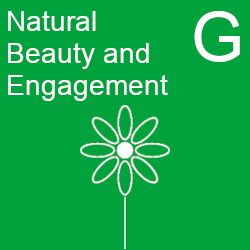Notice: From 01 December 2025, the Outcome Indicator Framework dashboard has been moved. Future updates to this publication are available on GOV.UK at: Environmental Indicator Framework.
Short Description
This indicator will track changes in people’s engagement with the natural environment. It is our objective that, alongside improvements in natural environments, people are also engaging more with them. Spending time in the natural environment is important for both human health and wellbeing, and increasing pro-environmental behaviours to support nature recovery.
A range of measurements may be indicative of engagement with the natural environment, but for the purposes of this indicator, data covering the broadest possible aspects of nature and engagement were sought. In addition, other measures of engagement relating to people’s care and concern for the environment are measured as part of indicators G5 People engaged in social action for the environment and G6 Environmental attitudes and behaviours.
Readiness and links to data
This indicator has been revised in the 2025 update of the Outcome Indicator Framework. It now presents data from 2 of Natural England’s nationally representative surveys on time spent in natural spaces (spanning a wide range of green and blue spaces, both urban and rural):
1) The Adults People and Nature Survey (A-PaNS) which began collecting data for adults on an on-going basis from 2 April 2020.
2) The Children’s People and Nature Survey (C-PaNS) which collects data for children twice yearly (beginning in August 2021), once during school holiday-time and once in term-time.
Work to compare A-PaNS data with Monitor of Engagement with the Natural Environment (MENE) survey data collected before 2020 found that due to changes in survey mode and questions, results from the 2 surveys cannot be compared and therefore, the MENE data have been removed from this indicator during the 2025 update. More information on A-PaNS and C-PaNS methods, outputs and the full questionnaires, are available on the People and Nature Survey (PaNS) homepage.
Summary data for all 4 components of this indicator are available in the Statistics and technical details for 2025 national indicators dataset.
Notes on indicator
Adults' and children’s results are not directly comparable due to the use of child-appropriate questions in the children’s surveys.
Indicator components
Figure G4a: Proportion of adults in England visiting green and natural spaces in the past 14 days, survey years 2020/2021 to 2023/2024
Table G4a: Proportion of adults in England visiting green and natural spaces in the past 14 days, survey years 2020/2021 to 2023/2024
| Year | At least one visit | No visits | Don't know and prefer not to say |
|---|---|---|---|
| 2020/2021 | 61.95 | 28.62 | 9.43 |
| 2021/2022 | 63.40 | 24.67 | 11.93 |
| 2022/2023 | 65.07 | 22.47 | 12.46 |
| 2023/2024 | 67.00 | 21.78 | 11.22 |
Trend description for G4a
The proportion of adults visiting green and natural spaces at least once in the past 14 days has increased by 5 percentage points over the last 4 years, from a little under 62% in 2020/2021 to 67% in 2023/2024.
Assessment of change
No assessment of change was undertaken for this indicator as a suitable time series is not yet available in the Outcome Indicator Framework.
Figure G4b: Gross annual number of visits to green and natural spaces by adults in England, survey years 2020/2021 to 2023/2024
Table G4b: Gross annual number of visits to green and natural spaces by adults in England, survey years 2020/2021 to 2023/2024
| Year | Value |
|---|---|
| 2020/2021 | 4.51 |
| 2021/2022 | 4.02 |
| 2022/2023 | 3.84 |
| 2023/2024 | 4.12 |
Trend description for G4b
In contrast to the increases seen in the proportion of adults visiting green and natural spaces (indicator G4a), results show that although there was an increase in the latest year’s figure, the gross annual number of visits to these types of spaces has fallen by 8.6% over the same time period, from just over 4.5 billion in 2020/2021 to a little over 4.1 billion in 2023/2024. In summary, it therefore appears that more adults are visiting green and natural spaces, but on average, each of these adults is visiting less frequently.
Assessment of change
No assessment of change was undertaken for this indicator as a suitable time series is not yet available in the Outcome Indicator Framework.
Figure G4c: Frequency of visits to green and natural spaces in the past 12 months by adults in England, survey years 2020/2021 to 2023/2024
Table G4c: Frequency of visits to green and natural spaces in the past 12 months by adults in England, survey years 2020/2021 to 2023/2024
| Year | At least once a week | Once or twice a month | Less than once a month | Never | Don't know and prefer not to say |
|---|---|---|---|---|---|
| 2020/2021 | 71.27 | 11.07 | 13.63 | 4.02 | 0.01 |
| 2021/2022 | 69.41 | 11.44 | 13.97 | 5.17 | 0.01 |
| 2022/2023 | 69.16 | 13.27 | 14.02 | 3.52 | 0.03 |
| 2023/2024 | 70.02 | 13.31 | 13.78 | 2.86 | 0.03 |
Trend description for G4c
In 2023/2024, 70% of adults said they had spent free time outside in green and natural spaces on average at least once a week in the past 12 months. This is similar to the figures reported over the last 3 years (71% in 2020/2021 and 69% in 2021/2022 and 2022/2023). Approximately 27% (from 25% in 2020/2021 and 2021/2022, to 27% in 2022/2023) said they spent free time outside in green and natural spaces less often than once a week, and around 3% (4% in 2020/2021 and 2022/2023 and 5% in 2021/2022) said they spent no free time outside in green and natural spaces.
Assessment of change
No assessment of change was undertaken for this indicator as a suitable time series is not yet available in the Outcome Indicator Framework.
Figure G4d: Frequency of time spent outside in the last week by children in England, survey years 2021 to 2024
Table G4d: Frequency of time spent outside in the last week by children in England, survey years 2021 to 2024
| Year | Location | Every day | Most days | Once or twice | Never | Don't know and prefer not to say |
|---|---|---|---|---|---|---|
| 2021 | In school | 59.64 | 28.18 | 9.59 | 1.57 | 1.02 |
| 2021 | Outside of school | 13.68 | 38.76 | 41.40 | 6.11 | 0.04 |
| 2022 | In school | 56.07 | 28.52 | 12.33 | 1.91 | 1.18 |
| 2022 | Outside of school | 12.46 | 37.69 | 43.40 | 6.41 | 0.05 |
| 2023 | In school | 56.76 | 30.35 | 10.57 | 1.47 | 0.85 |
| 2023 | Outside of school | 11.73 | 34.69 | 47.47 | 4.85 | 1.26 |
| 2024 | In school | 52.33 | 32.19 | 13.13 | 1.90 | 0.45 |
| 2024 | Outside of school | 10.79 | 35.68 | 47.08 | 5.22 | 1.22 |
Trend description for G4d
In 2024, C-PaNS results show that when thinking about the last week, 52% of children said they spent time outside every day when at school. This is a small decrease in the numbers reported over the past 3 years (60% in 2021, 56% in 2022 and 57% in 2023). Around 32% of children (28% in 2021, 29% in 2022 and 30% in 2023) had spent time outside most days, 13% (10% in 2021, 12% in 2022 and 11% in 2023) had spent time outside once or twice, and a small percentage (between 1% and 2% across all 4 survey years) had not spent time outside at all.
Children reported spending time outside less frequently when not at school in all 4 years. For example, in 2024, 11% of children said they had spent time outside every day when not at school; this also represents a small decrease in the numbers reported over the past 3 years (14% in 2021 and 12% in 2022 and 2023). A little less than 36% of children (39% in 2021, 38% in 2022 and 35% in 2023) had spent time outside most days, a little more than 47% (41% in 2021, 43% in 2022 and 47% in 2023) had spent time outside once or twice, and around 5% (in all 4 years) had not spent time outside at all.
Assessment of change
No assessment of change was undertaken for this indicator as a suitable time series is not yet available in the Outcome Indicator Framework.

